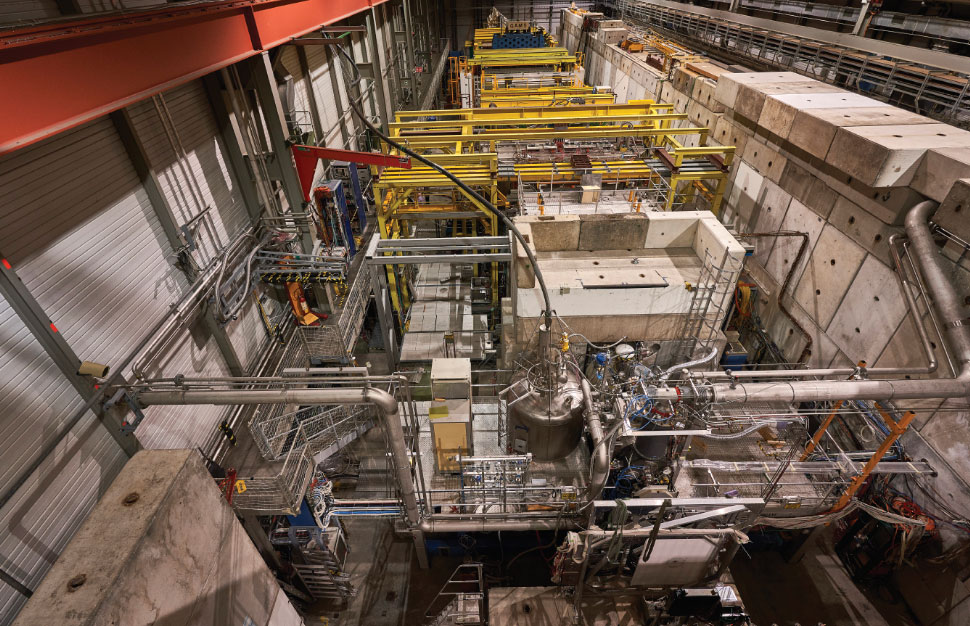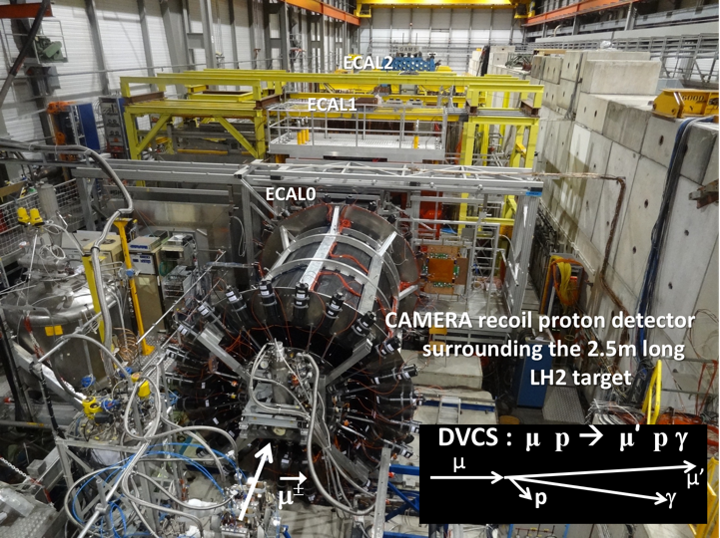Searching for new physics with hadrons and muons at SPS
CERN is not only home to the LHC but provides a diverse physics programme using the LHC injector complex including the PS and the SPS that deliver a range of high-energy beams to a number of experiments. In order to fully exploit the scientific potential of the existing infrastructure, CERN launched in 2016 the Physics Beyond Collider (PBC) initiative that brought together a wide range of physicists from the theory, experiment and accelerator communities to explore the full range of research opportunities.
The lack of observation so far of new high-mass states at the LHC informs a wide range of theories describing new physics beyond the framework of the Standard Model. These theories are well motivated both by theory and from phenomenology and a wide range of models can be tested in experiments that complement collider searches.
A number of proposals have been submitted to PBC covering a wide range of alternatives: precision and rare decay experiments, beam-dump experiments and low-mass axion searches while a number of proposals focus on specific QCD measurements. The proposed experiments are sensitive to New Physics in a range of masses and couplings inaccessible to other existing or planned initiatives in the world offering strong complementarity in the search for new physics.

Three of these proposals plan to use the external SPS M2 beam line in the experimental hall EHN2. The M2 line, currently serving the COMPASS experiment, is able to provide muons with momentum of ' (100−160) GeV/c, and intensity up to ∼ 108 µ/spill. The proposed experiments aim to address two of the biggest puzzles for modern physics: the deviation of the muon magnetic moment (g-2) from the Standard Model prediction and the possible presence of relatively light “dark photons” that could shed light on entire dark sectors of the Universe made up of dark matter. The unprecedented precision of such experiments allows a wide range of new physics to be tested.
COMPASS++/AMBER: A new QCD facility at SPS
In the period 2015-2018, the long standing COMPASS experiment in CERN's North Area has completed several measurement periods using the versatile two-stage open aperture forward spectrometer located in the EHN2 hall. Different experimental setups were installed in the target region enabling a diverse physics programme. In 2015 and 2018, the Drell-Yan (DY) process was studied using positive pions delivered by the high-energy M2 hadron beam line and various types of heavy targets. In 2016 and 2017, the Deeply Virtual Compton Scattering (DVCS) process was studied using both charge signs of the high-energy polarised muons delivered by the M2 beam line in conjunction with a 2m-long unpolarised hydrogen target surrounded by a recoil-proton detector.
The data collected during these periods are being analysed and preliminary results have improved our understanding on a number of processes while also helping to interpret results from other experiments. Here, the COMPASS menu of results includes polarised quark PDFs, Transverse -Momentum-Dependent (TMD) PDFs and Generalised PDFs as well as DIS multiplicities of pions and kaons. Using data taken in earlier measurement periods, COMPASS has performed high-statistics partial-wave analyses of exclusive 3-pion final states and obtained spectroscopic results on standard and exotic mesons.

Figure 1. One of the experimental configurations of the COMPASS facility at SPS M2 beam line
These results on hadron structure and spectroscopy have considerably extended our understanding of QCD and serve as well as input to further theoretical developments. Motivated by the successful COMPASS-II history and profiting from the unique capabilities offered by the M2 beam line in conjunction with the versatile two-stage spectrometer in the EHN2 hall, recently a broad experimental programme was proposed for the M2 beam line of the SPS. The COMPASS++/AMBER collaboration proposes to continue on the shorter term a programme with the existing M2 beam options while a number of second-generation experiments would be made possible relying on high-energy, high-intensity RF separated hadron beams.
The first measurement proposed by COMPASS++/AMBER for phase-1 (2022-2024) is a precision determination of the electric mean square charge radius using muon-proton elastic scattering. This measurement will complement those of other approaches in this field to solve the "proton-radius" puzzle and will help understanding the underlying reason for the existing mismatch by up to 5 σ between the two most precise existing measurements (CREMA and MAMI).
Figure 2. The ratio between the electric form factor of the proton and its dipole formula. The sensitivity of the proposed COMPASS++/AMBER measurement is shown as a band around the line corresponding to a proton charge radius of 0.84 fm.
The second important goal of COMPASS++/AMBER phase-1 is the experimental investigation of the meson structure using the Drell-Yan process. These measurements are critical input to theoretical efforts to explain the emergence of massive composite hadrons, including the large mass difference between the pion and the proton. The main focus will be to determine the nearly unknown parton distributions of pions and kaons.
Last but not least, in phase-1 of their programme COMPASS++/AMBER aims to measure with high precision the antiproton production cross sections using low energy antiprotons colliding on proton and 4-helium targets. The new data set will thus substantially improve the sensitivity of existing (and future) very accurate AMS antiproton flux measurements to Dark Matter signals, which is presently limited by the poor knowledge of the antiproton production cross sections. These data can be combined with similar measurements from LHCb in the TeV regime.
In the long term, COMPASS++/AMBER aims to establish a world-unique QCD facility that will use the external SPS M2 beam line in conjunction with a universal spectrometer in the experimental hall EHN2. This facility would profit from an RF separation stage to produce high-intensity and high-purity kaon and antiproton beams, which is also studied by EN-EA in the context of the Physics Beyond Colliders Initiative. A wealth of measurements are proposed, including Drell-Yan measurements of the Kaon structure, a Primakoff measurement of the Kaon polarisability and a comprehensive high statistics survey of strange spectroscopy using the powerful Partial Wave Analysis technique developed by COMPASS. This phase will also require detector development efforts as well as a new trigger system that will allow the physics goals to be met.
The full project is expected to span a timescale of almost fifteen years, adding to CERN’s diverse physics programme. As the proposal for COMPASS++/AMBER continues to attract physicists world-wide, the physics scope of the facility will remain open for future exciting ideas, using either (RF-separated) hadron beams or the muon beam, welcoming ideas for new experiments exploiting the opportunities offered by this facility.
You can read HERE a more detailed overview of the proposed experimental facility.
NA64++, exploring the dark sector with muon beams.
The recent results of NA64e demonstrated the potential of the active beam dump approach combined with missing energy to search for dark sector at the SPS. This motivated the NA64 Collaboration to propose a new experiment called NA64μ aiming for such a search with the M2 muon beam at the SPS. NA64μ would probe the dark photon (A´) invisible decay similar to NA64 running in the electron mode (NA64e). Running with muons increases the sensitivity of the experiment to higher A’ masses.
The combined NA64e and NA64μ results with ~1013 EOT and a few 1013 MOT, respectively, will thus allow to cover almost fully the parameter space of the most interesting sub-GeV DM models shown in Fig. 4. This plot presents the current limits of NA64 and previous beam dump experiments in the (y,mX) plane, where mX is the dark matter mass and y is a variable proportional to the dark matter- standard model annihilation cross section, which is convenient for comparison of results from other experiments. The black curves represent the DM relic abundance calculated for scalar, Majorana and Pseudo-Dirac particles, which is an explicit target for NA64.
This makes NA64e and NA64μ extremely complementary to each other and greatly increases the exploratory power of sub-GeV DM searches with CERN’s SPS.

Figure 4: Current bounds and projected combined sensitivity of NA64e - NA64μ
An additional motivation for NA64μ is the muon (g-2)μ anomaly, which is under more accurate study by the currently running experiment E989 at FNAL. While the A´ explanation of the muon g-2 anomaly has been ruled out by NA64 and BaBar, there is still one remaining interesting explanation provided by the Lμ – Lτ model. This could be probed by NA64μ already with ~1011 MOT.
Remarkably, with the statistics accumulated during years 2016-2018 NA64 already began probing the sub-GeV DM parameter space for the conventional value of αD=0.1, while with a data sample of slightly higher than 1013 EOT plus 2x1013 MOT this area will be completely explored.
A third proposal is MUonE. The main goal is to explore the contribution of the hadronic vacuum polarization (HVP) to the muon g-2 discrepancy with a new experimental method. Currently the experimental value of the muon anomaly is measured with an uncertainty of 0.54 parts per million and disagrees with theoretical predictions at a 3.5 σ level. Results from next generation (g-2) experiments at Fermilab (USA) and J-PARC (Japan) are expected to reach the impressive precision of 0.14 parts per million.
In order for theoretical predictions to match the experimental measurements a more precise measurement of the contributions from the hadronic vacuum is needed. This is the goal for MUonE, building on CERN’s previous tradition.The collaboration proposes a novel method to determine this contribution. To do so they plan to measure the momentum transfer distribution (t) in elastic µ-e scattering.
To reach the required precision, MUonE needs a high energy muon beam, covering a region in t up to the value of t = -0.108 Gev2 (if Eμ = 150 GeV), where the hadronic corrections affect mostly the cross-section. The M2 muon beam energy of 150 GeV will allow to collect data covering ~87% of the cross-section curve (see Fig.5) whose integration allows to measure aµHLO whose uncertainty dominates the SM prediction. The remaining part of ~13% cannot be experimentally measured but can be determined by using time-like data and perturbative QCD, or eventually lattice QCD calculated results. With a muon beam with an average flux of the order of 107 μ’s/s as the one present in the CERN North Area complex, a statistical accuracy of the order of 0.3% for aµ can be reached with few years of data taking. The challenge of the proposed measurement is the control of the systematics, both on the theoretical and experimental side, at a comparable level of accuracy.
Figure 5. MUonE plans to measure the quantity aµHLO by comparing the shape of the muon-electron elastic scattering differential cross-section as a function of the momentum transfer in the space-like region, with the theoretical predictions calculated with adequate precision. This means to measure the integrand shown under the smooth function shown above.
In 2018 MUonE ran parasitically with a test beam set-up downstream of the COMPASS experiment to check the beam conditions and provide input to the trigger strategy.
Read HERE more about the MUonE proposal.
Conclusion
The time sharing in the highly demanded M2 beam line between the three proposed facilities is an issue that will be further discussed as it requires careful planning and prioritization of the operations. Optimal use of the high-intensity µ-beam requires to strengthen the studies in order to fit the programs together, and is being investigated by the SPSC.
Note: The author would like to thank: Oleg Denisov, Jan Friedrich, Wolf-Dieter Nowak (COMPASS++/AMBER), Sergei Gninenko & Paolo Crivelli (NA64) and Clara Matteuzzi (MUonE) for providing detailed summaries on which this article is based. You can read them by following the links at the end of each proposal.
